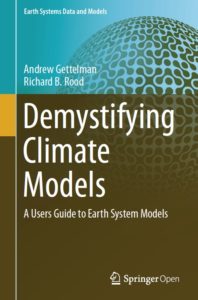Resource Blog

The Resource Blog, linked here, contains links to resources that have been collected for classes. It includes recorded lectures.
The Resource Blog is regularly updated.
Feature: 2020 Master’s Project: Evaluating the Impacts of Sea Level Rise and Storm Surges on Seychelles’ Critical Infrastructure (Direct link to PDF of complete report (132 MB))
Image: Chaos and order, 2008 Galvanized wire, 60x60x60cm. Barbara Licha (from Ultimo Project Studios)
The Practitioner’s Dilemma

Suppose you are a city planner, regional water manager, or wildlife conservation specialist who is asked to include the potential impacts of climate variability and change in your risk management and planning efforts. What climate information would you use?
Read The Practitioner’s Dilemma: Link to open access article
Demystifying Climate Models

Demystifying Climate Models is designed to be a guide to climate simulation and prediction for the non-specialist and an entry point for understanding uncertainties in climate models. The goal is to give the reader an understanding of the philosophy and practice behind climate models. The book will also be valuabel for graduate students in other scientific disciplines who may want to use climate models in their research.
Abstract
Demystifying Climate Models is designed to be a guide to climate simulation and prediction for the non-specialist and an entry point for understanding uncertainties in climate models. The goal of the book is not to be simply a popular guide to climate modeling and prediction, but to help those using climate models to understand the results. This book provides background on the earth’s climate system and how it might change, a detailed qualitative analysis of how climate models are constructed, and a discussion of model results and the uncertainty inherent in those results.
Who is this book for?
This book is designed as a qualitative and schematic descrption of climate models. The goal is to give the reader an understanding of the philosophy and practice behind climate models. It is appropriate for undergraduates and graduate students learning about climate change and climate policy. It is also appropriate as an introduction for those with a background in meteorology. The book will also be valuable for graduate students in other scientific disciplines who may want to use climate models in their research. It is not a guide for designing climate models. It is a guide for their use, with a focus on uncertainty in model output, and framing that uncertainty so models are useful for different problems.
Demystifying Climate Models is available as a free ebook at this link.